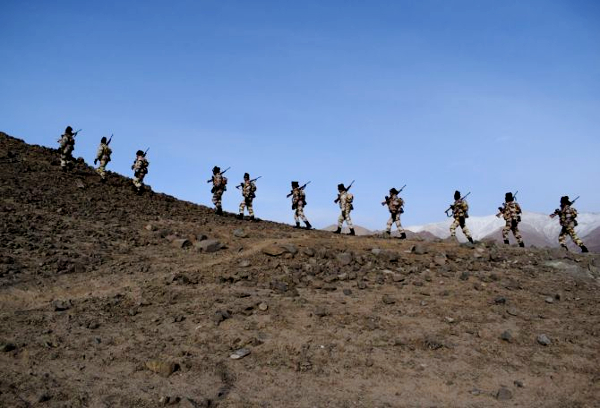New Delhi, Dec 18: It took a lot of grit and determination to wade away the Chinese threat at Dolkam. It was the timely action of India’s security forces that checked the People’s Liberation Army from continuing with their road construction activity in South Doklam.
The grit of the Indian Army coupled with 13 rounds of diplomatic discussions between India and China finally led to the resolution of the Doklam standoff.
The report by the committee on External Affairs termed the Chinese intrusion at Doklam as a “blatant but unsuccessful attempt” to unilaterally change the status quo at the India, Bhutan, China tri-junction in Doklam, seriously affecting India’s security interests.
The committee also referred to 24 rounds of boundary talks between China and Bhutan and said China has been trying to persuade it to barter Doklam for some other territory further north and that Bhutan requires all support and assurances from its “time tested” ally India for it to take a firm position on this issue.
Complimenting the government’s handling of the face-off, the committee said it remained concerned that Chinese infrastructure built “uncomfortably” close to the tri-junction has not yet been dismantled.The committee, headed by former minister of state in External Affairs Ministry Shashi Tharoor, said Doklam was not a sovereignty issue for India as the disputed territory was Bhutanese, but nevertheless it was a major security challenge for New Delhi.
“The committee would like to put on record their highest appreciation for the brave and timely action of our security forces which checked the PLA (People’s Liberation Army) troops from continuing with their road construction activity in South Doklam,” the panel said in the report tabled in Parliament on Monday.
Troops of India and China were locked in a 73-day face-off in Doklam from June 16 last year after the Indian side stopped the building of a road in the disputed area by the Chinese Army. The impasse ended on August 28. The report quoted the then Foreign Secretary S Jaishankar as telling the panel on October 18 last year that 13 rounds of diplomatic discussions were held with China and they were led by the Indian envoy in Beijing.Vijay Gokhale, who succeeded Jaishankar as Foreign Secretary in January, was India’s Ambassador to China during the Doklam crisis.
The report said diplomatic communications with China began following Prime Minister Narendra Modi’s conversation with Chinese President Xi Jinping in Hamburg on July 7 last year on the sidelines of the G20 summit.In the talks, India contested the Chinese claim of sovereignty in Doklam region, conveyed to Beijing that its action represented a significant change in status quo with serious security implications for India and amounted to unilateral determination of the tri-junction point, according to then foreign secretary.
The committee complimented the government’s overall handling of the crisis as it managed to send necessary signals to China that India will not “acquiesce” in its unilateral and forceful attempts to change the status quo at any of India’s territorial boundaries.It expressed concerns over multiple reports which allude to Chinese presence around Doklam plateau and the statements from Chinese authorities about chances of similar happenings in future also even after the standoff at Doklam ended.
“The government has categorically denied that there is any direct threat from Chinese troops presently. The committee, however, are of the opinion that while dealing with China, it is always better to have a sense of ‘healthy scepticism’,” it said.The panel said India’s defence forces and the diplomatic corps have shown firmness in responding to the crisis without actually being drawn into any kind of political rhetoric.The foreign secretary was quoted in the report as saying that during the entire course of the Doklam standoff, the ground situation was “very civil and that there was no body contact”.
To avoid border skirmishes, the panel strongly desired that a comprehensive Border Engagement Agreement is concluded between the Indian Army and the PLA, subsuming all established mechanisms for confidence building between the two sides.It also said that it was not the first time that PLA troops entered the Doklam area and that the Chinese troops have been crossing the Batang La-Meruga La-Sinchela Ridge line over the years and making ingress into the Bhutanese territory.
The Committee also expressed unhappiness over grossly inadequate border road infrastructure along the India-China frontier.It was of the opinion that an objective and in-depth assessment of India’s relationship with China should be carried out by the government promptly so that a broad national consensus is evolved on how to deal effectively with China.
Source:OneIndia
Image Courtesy:Rediffmail
You may also like
-
IAF Aircraft Set Course For Exercise Eastern Bridge VII At Oman
-
Trade Connect E-platform For Exports Is Single Window, Fast, Accessible And Transformational: Shri Piyush Goyal
-
India-us Working Together In Areas Like Critical Minerals, Supply Chains And Advanced Technologies: Shri Piyush Goyal
-
Dot Simplifies Approval Processes For Telecom Licenses And Wireless Equipment
-
Coal Production and Supply Trends on Positive Trajectory
